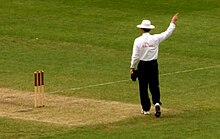Umpires and scorers
Main articles: Umpire (cricket) and Scorer
The game on the field is regulated by two umpires, one of whom stands behind the wicket at the bowler's end, the other in a position called "square leg", a position 15–20 metres to the side of the "on strike" batsman. The main role of the umpires is to adjudicate on whether a ball is correctly bowled (not a no ball or a wide), when a run is scored, and whether a batsman is out (the fielding side must appeal to the umpire, usually with the phrase How's That?). Umpires also determine when intervals start and end, decide on the suitability of the playing conditions and can interrupt or even abandon the match due to circumstances likely to endanger the players, such as a damp pitch or deterioration of the light.
Off the field and in televised matches, there is often a third umpire who can make decisions on certain incidents with the aid of video evidence. The third umpire is mandatory under the playing conditions for Test matches and limited overs internationals played between two ICC full members. These matches also have a match referee whose job is to ensure that play is within the Laws of cricket and the spirit of the game.
The match details, including runs and dismissals, are recorded by two official scorers, one representing each team. The scorers are directed by the hand signals of an umpire. For example, the umpire raises a forefinger to signal that the batsman is out (has been dismissed); he raises both arms above his head if the batsman has hit the ball for six runs. The scorers are required by the Laws of cricket to record all runs scored, wickets taken and overs bowled; in practice, they also note significant amounts of additional data relating to the game.

No comments:
Post a Comment